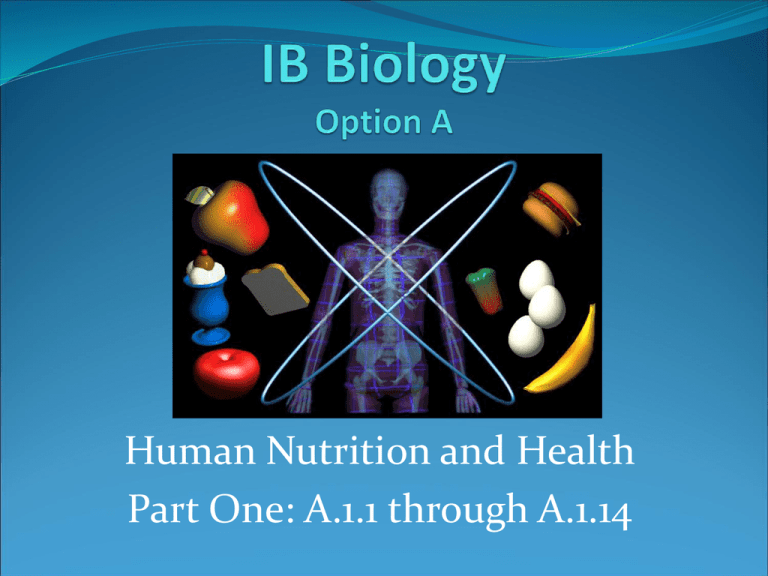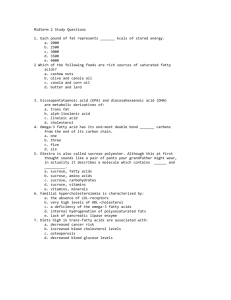IB Biology Option A
advertisement

Human Nutrition and Health Part One: A.1.1 through A.1.14 VOCABULARY LIST FOR A1.1. THROUGH A.1.14 Nutrient Balanced diet Lipid Protein Carbohydrate Fatty acid Mineral Vitamin Amino acid Water Malnutrition Phenylalanine hydroxylase Essential fatty acid Vitamin A Vitamin B Vitamin C Vitamin D Iodine Deficiency disorder A.1.1. Define nutrient: A chemical substance found in foods that is used in the human body. There are five main types of nutrients: carbohydrate, protein, lipid, minerals, and vitamins. A.1.2 What nutrients are essential in the human diet? Essential nutrients are those that cannot be synthesized by the body: amino acids, fatty acids, minerals, vitamins, and water. Carbohydrates are not included because in certain human diets, the energy is obtained from other sources without ill effect. A.1.3. State that non-essential amino acids can be synthesized in the body from other nutrients.7 Many foods contain protein, such as beef, salmon, seeds, nuts, and soybean products. Proteins food are digested into amino acids, which are absorbed and used in protein synthesis. Protein synthesis allows growth, regeneration of hair, nails, blood, and skin, and the repair of damaged tissues. A.1.4. Outline the consequences of protein deficiency malnutrition. Protein deficiency is the result of a shortage of essential amino acids: it can cause a lack of BLOOD PLASMA PROTEINS and thus TISSUE FLUID RETENTION, and SWELLING OF THE ABDOMEN. Children who suffer from portein deficiency are more likely to be mentally and physically retarded. The most reliable sources of essential amino acids are meant, eggs, cheese, and other animal products. Protein deficiency seems most common in foreign countries in Africa and Latin America. Malnutrition can be caused by economic, environmental, social, and cultural factors. A.1.5 Explain the causes and consequences of phenylketonuria (PKU) and how early diagnoses and a special diet can reduce the consequences. Phenlyketonuria, or PKU, is an autosomal recessive genetic disorder in which the enzyme phenylalanine hydroxylase (PAH) is deficient and cannot metabolize the amino acid phenylalanine to the amino acid tyrosene. When this occurs, phenylalanine accumulates and instead of being metabolized into tyrosene, is converted into phenylpyruvate. With no treatment, it can cause problems with brain development and lead to mental retardations and cause seizures. There is no known cure, and the damage is irreversible. Early diagnoses is crucial. PKU is one of few genetic diseases that can be controlled by diet: one who has PKU must eat a diet low in phenylaline (staying away from foods like meat, chicken, fish, and nuts) and high in tyrosene. A.1.6 Outline the variation in the molecular structure of fatty acids, including saturated fatty acids, cis and trans unsaturated fatty acids, monounsaturated and polyunsaturated fatty acids. Example of a saturated fat: saturated carbon atoms. Example of a trans-unsaturated fatty acid. Unsaturated carbon atoms. Example of a cis-unsaturated fatty acid: unsaturated carbon atoms. Essential fatty acids, or EFAs, are fatty acids that cannot be constructed within an organism from other components (generally all references are to humans) by any known chemical pathways; and therefore must be obtained from the diet. The term refers to those involved in biological processes, and not fatty acids which may just play a role as fuel. As many of the compounds created from essential fatty acids can be taken directly in the diet, it is possible that the amounts required in the diet (if any) are overestimated. It is also possible they can be underestimated as organisms can still survive in unideal, malnourished conditions. In biochemistry and nutrition, monounsaturated fats are fatty acids that have a single double bond in the fatty acid chain and all the carbon atoms in the chain are single-bonded. By contrast, polyunsaturated fatty acids have more than one double bond. In nutrition, polyunsaturated fat is an abbreviation of polyunsaturated fatty acid. That is a fatty acid in which more than one double bond exists within the representative molecule. That is, the molecule has two or more points on its structure capable of supporting hydrogen atoms not currently part of the structure. Polyunsaturated fatty acids can assume a cis or trans conformation depending on the geometry of the double bond. A.1.7 Evaluate the health consequences of diets rich in the different types of fatty acid. Many animal products are considered “complete,” meaning they have all the essential amino acids in their right proportions. “Incomplete” foods are deficient in one or more essential amino acids. Corn, for example, is deficient in the amino acid lysine. People forced by economic necessity or other circumstances to obtain nearly all of their calories from corn would show symptoms of protein deficiency, as would those who eat only rice, wheat, or potatoes. The problem can be avoided by eating a combination of plant foods that can complement one another to supply all essential amino acids (Campbell 853). For example, beans supply the lysine that is missing in corn: and while beans are deficient in methionine, this essential amino acid is present in corn. A.1.8 Distinguish between mineral and vitamins in terms of their chemical nature. A mineral is a chemical element. At least 20 different minerals are essential to the human body, such as zinc, or iodine, and must be ingested in sufficient quantities to prevent a deficiency disease. A vitamin is an organic compound. They are needed in the body in small quantities, but cannot be synthesized in the body . Examples include Retinol, Ascorbic Acid, and Tocopherol. A.1.9 Outline 2 of the methods that have been used to determine the recommended daily intake of Vitamin C. This includes in vitro research and retrospective research ( looking back at diseases and events) In vitro research adds vitamin C to various cellular components and looks at the results. Retrospective research looks at the diseases caused, and the levels of vitamin C in those suffering them.They also looked extensively at the diet of Inuits, who do not each much plant matter at all, yet do not get scurvy. A.1.10 Discuss the amount of vitamin C that an adult should consume per day, including the level needed to prevent scurvy, claims that higher intakes give protection against upper respiratory tract infections, and the danger of rebound malnutrition. This is Vitamin C. This is a more important vitamin C: RDA is 65-90 mg a day ( less for women) Maximum dosage RDA is 2,000mg/day Linus Pauling took 6,000-18,000 mg /day. Some current scientists recommend up to 3,000 mg/day Scurvy is prevented with 40 mg/day Vitamin C, or ascorbic acid, is an essential nutrient to mammalian bodies. Vitamin C is used as an antioxidant, acting to lessen oxidative stress. It acts as an “electron door” for eight different enzymes, it is a substrate for ascorbic peroxidase, and an enzyme cofactor for the biosynthesis of many important biochemicals. Vitamin C helps prevent scurvy, which occurs when the lack of the vitamin prevents collagen from functioning. Scurvy leads to liver spots on the skin, spongy gums, and bleeding from mucous membranes. To prevent scurvy and other potential sicknesses (it can be argued that a higher intake can prevent respiratory infections, and also rebound malnutrition), there is a recommended daily intake of vitamin C. Vitamin C is used in collagen synthesis, and it aids in detoxification. It also improves iron absorption, and as mentioned before, is an antioxidant. The recommended daily intake of Vitamin C is almost as debated as Obama versus Hilary, but the World Health Organization recommends 45 milligrams per day to prevent sickness. However, too large of doses can cause indigestion and diarrhea. Rebound malnutrition occurs when a normally adequate intake of a vitamin follows a period of excessive intake and excretion. Foods with Vitamin C: fruits and vegetables (esp. citrus fruits, broccoli, cabbage, tomatoes, and green peppers. A.1.11 List the sources of vitamin D in human diets. Sources of Vitamin D: Vitamin D can be found in dairy products and egg yolks, but is also made in the human skin in the presence of sunlight. Vitamin D is needed for calcium absorption in the intestines. It helps keep calcium levels in the blood within narrow limits and ensures that sufficient calcium is supplied to muscles and bones. A.1.12 The risk of Vitamin D deficiency from insufficient exposure to sunlight balanced against the risk of contracting malignant melanoma. Vitamin D regulates the calcium and phosphorus levels in the blood by promoting their absorption from food in the intestines, and by promoting re-absorption of calcium in the kidneys. It promotes bone formation and mineralization and is essential in the development of an intact and strong skeleton. It inhibits parathyroid hormone secretion from the parathyroid gland. Vitamin D affects the immune system by promoting phagocytosis, anti-tumor activity, and immunomodulatory functions. As mentioned previously, the presence of sunlight allows the human skin to produce Vitamin D in large quantities. However, the ties between an overproduction in Vitamin D and the contraction of malignant melanomas are greatly disputed: The use of sunscreen and sun protection factors can inhibit the production of Vitamin D up to 90%. Studies have shown that those who do use protection against the sun regularly are more likely to become Vitamin D deficient. However, and somewhat ironically, many other studies suggest that Vitamin D deficient individuals are more likely to contract certain types of skin cancer: An estimate of premature cancer mortality in the U.S. due to inadequate doses of solar ultraviolet-B radiation. A.1.13 Explain the benefits of artificial dietary supplementation as a means of preventing malnutrition, using iodine as an example. Artificial dietary supplementation is the addition of a dietary supplement into the diet of an individual to prevent a deficiency of that particular nutrient and thus malnutrition. An example would be the frequency of iodine deficiency disorder (IDD), which causes swelling of the thyroid in the neck. This is called goiter, which is most common in the Central African Republic and Syria but can be found in all parts of the world. Goiter is very serious: if women are affected during pregnancy, their children are born with permanent brain damage. If children suffer from IDD after birth, their mental development and intelligence are impaired. In 1990, a campaign was started to eliminate IDD by adding it in small quantities to salt sold for human consumption. By adding iodine to salt and providing that salt to populations suffering from IDD, the number of those suffering diminished significantly. In 2000, iodized salt was reaching more than 3.3 billion people throughout the world. A.1.14 Outline the importance of fiber as a component of a balanced diet. Many populations in undeveloped countries suffer from malnutrition and the deficiency of nutrients. However, even in industrialized countries, individuals can suffer from deficiencies. Fiber cannot be digested in the small intestine. Cellulose from plant cell walls is the main component of dietary fiber, but there are other components including chitin, and lignin. Soluble fiber ferments in the large intestine, which provides necessary short chain fatty acids from the bacteria. Fiber has been shown to help prevent constipation by increasing the bulk of material in the large intestine. Fiber may reduce the risk of diseases of the large intestine including appendicitis, cancer, and hemorrhoids. It can also prevent obesity by increasing the bulk in the stomach, which reduces the desire to eat more food. Fiber can increase the rate of absorption of calcium.







